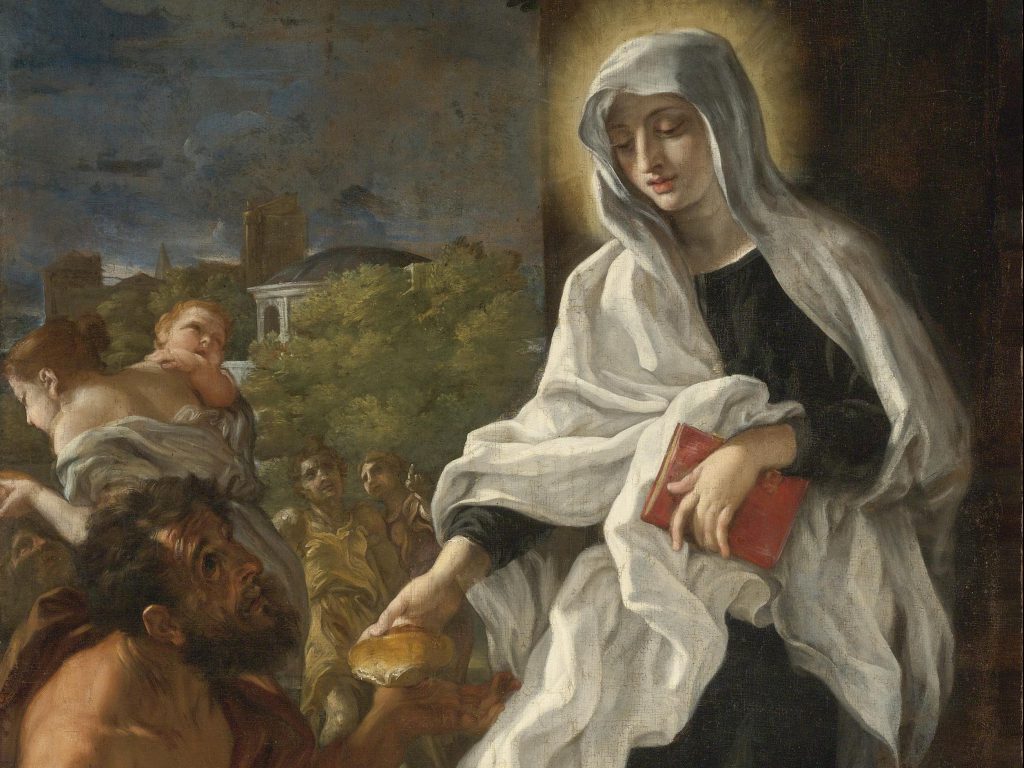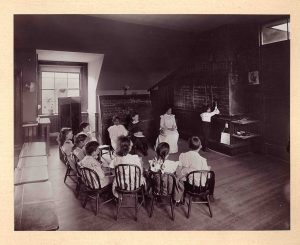Francesca had always shown great piety at a young age and she wanted to pursue the road to becoming a nun. But following her family’s wishes, to marry into a religious family with wealth, she married Lorenzo Ponziano and the two would have a family including three children. In 1400, a year after Francesca had given birth to her first son, Lorenzo’s mother died. With the head of the house being vacant, Lorenzo’s family, mainly Lorenzo’s father Andreazzo, decided Francesca would take over the management and domestic affairs of the household. Francesca protested the decision, claiming her inexperience and youth didn’t make her the best for the role. She argued that Vannozza, the wife of the eldest Ponziano son, should be granted the position. Despite her cries, the Ponziano men insisted she should be in charge because of her wisdom and virtue. Unable to deny her family’s eagerness and pleas, especially Andreazzo’s, Francesca became the head of the richest house in Rome.1

Francesca led the people in her house with firm kindness no matter the relation she had with them. Servants were treated with love and patience, and given encouragement to follow the word of God. She never spoke badly to a servant and she would give them enough leisure time to attend not just Sunday mass but masses on holidays and special occasions. She also expressed the desire for her servants to pass down her compassion to whomever they crossed paths with. About a year after Francesca took on her new role, Rome started to experience famine and disease. Francesca prohibited her servants from turning down any poor person who came to the wealthy Ponziano family for help. She told her servants they could not send away anyone without their request being fulfilled, but unsatisfied with that, she eventually stepped in herself. She would greet each beggar personally and invite them in while she gathered supplies of corn, wine, oil, and clothing for them. Like with her servants, she would also encourage them to follow God, pray regularly, and fulfill their other religious duties. Francesca’s giving did not stop there, as she and Vannozza would visit hospitals and other far corners of the city to give out more supplies.2
Her charity, however, did not go over well with everyone, as Andreazzo grew alarmed that Francesca’s constant giving could possibly backfire on their own family. Fearful of a famine happening in his own home, he restricted the supplies available to Francesca and Vannozza. First, he started by taking away their keys to the granary, but to avoid caving in to their pleas, he started to sell the corn that wasn’t needed to feed the family in their daily life. He followed the same strategy with the wine cellar and sold all the extra wine except for one cask for the family. As each day passed, though more people in Rome started to suffer, Francesca couldn’t stand by and do nothing. Francesca and Vannozza pushed down any repulsion and shame they might have felt as they took to the streets to beg for the poor. They visited churches, palaces, and followed the rich around in public with tears in their eyes to receive whatever donations they could get. Although happy with what they could collect, they weren’t so happy with the harsh judgment, sneers, and insults they endured while crying for mercy for others. While doing this, Rome’s famine reached its peak and the streets were lined with practically naked, starving, and sick people calling out for death to put an end to their suffering. Francesca was devastated by the groans of pain and the sight of the countless ghastly faces. She would be haunted by this experience day and night. She felt that she would have done anything to end their suffering. She would have even gladly shed her own blood and fed them with her own life.3

One day, Francesca was hit with a thought to look in the corn-loft hay piles, as that was what mostly occupied it without the abundance of now sold corn, for any extra corn she could find that she could give to the poor. She had Vannozza and their closest pious servant, Clara, help with the search. The three spent hours on their knees digging through the hay, and triumphantly at the end of it, they collected a measure of corn. Just as the group was exiting the loft, Lorenzo walked into the granary and froze in shock because of what he saw. There in the place of the giant pile of hay that the women had just gone through was miraculously 40 measures of corn. The corn was bright yellow and looked so pristine that it looked like it could have been grown in heaven by angels themselves. Despite this one miracle, the poor needed more than just corn; they also came to the doorstep begging for wine. Francesca was defenseless to deny the numberless elderly men, young children, mothers with infants, and priests. So she took from the only cask of wine they had until every drop was given away. Once Andreazzo found out about the empty cask, he raged at Francesca as he never had done before, as this was the first time he was angry with her. “Charity indeed! Charity begins at home; a pretty sort of virtue this, which, under the pretext of assisting strangers, introduces penury and privation into the midst of a person’s own family,” he exclaimed.4 The other men of the household took Andreazzo’s side and also expressed anger at Francesca. But Francesca did not react harshly to the abuse, but instead, she quietly prayed. She then replied to them in a gentle voice, “Do not be angry; let us go to the cellar; may be, through God’s mercy, that the cask may be full by this time.”5 Begrudgingly, the men followed her to the cellar to watch her stop in front of a barrel and take out the cork. Instantly, exquisite wine started pouring out of it, a wine that Andreazzo confessed to being the best he had ever tasted in his life. Andreazzo turned to Francesca with tears spilling out of his eyes and cried, “Oh, my dear child, dispose henceforward of every thing I possess, and multiply without end those alms that have gained you such favour in God’s sight.”6

The story of this miracle was spread around, and humble Francesca did not protest it. She wanted this experience to show the Divine power in almsgiving and motivate the wealthy to give more to the poor, especially to the poor who followed God’s word. At the sight of so many miraculous acts, Lorenzo grew a new respect for Francesca’s dedication to her faith. He then encouraged her to follow any Divine act she wanted and dismissed her of her role in the household. Free from this responsibility, she was given complete freedom to do whatever she pleased at any time she desired. It wasn’t too long until Francesca was off doing what she always wanted to do. She sold all of her expensive dresses, jewels, and ornaments and gave the collected money to multiple poor families. She sacrificed a lot to give to others, not just material things as she would only wear her only old green dress after selling her others, but her body as well. She fasted immensely so she was able to give her portions of food away and she spent so much time trying to help the poor that she looked ill and fragile. It was believed that her health was so concerning that there was no other way she could have survived doing the amount of work she did without miraculous support. Francesca would later on in her life open up a monastery for nuns, who would later be known as the Oblates of St. Frances of Rome. Francesca passed away in 1440, at the age of 56, and was immediately canonized by Pope Paul V.7
- New Catholic Encyclopedia, 2003, s.v. “Frances of Rome, St.,” by M. Monaco. ↵
- Lady Georgiana Fullerton and J.M. Capes, The Life of St.Frances of Rome: Of Blessed Lucy of Narni, of Dominica of Paradiso, and of Anne de Montmorency (New York: P. J. Kenedy, 1901), 33. ↵
- Lady Georgiana Fullerton and J.M. Capes, The Life of St.Frances of Rome: Of Blessed Lucy of Narni, of Dominica of Paradiso, and of Anne de Montmorency (New York: P. J. Kenedy, 1901), 34. ↵
- Lady Georgiana Fullerton and J.M. Capes, The Life of St.Frances of Rome: Of Blessed Lucy of Narni, of Dominica of Paradiso, and of Anne de Montmorency (New York: P. J. Kenedy, 1901), 35. ↵
- Lady Georgiana Fullerton and J.M. Capes, The Life of St.Frances of Rome: Of Blessed Lucy of Narni, of Dominica of Paradiso, and of Anne de Montmorency (New York: P. J. Kenedy, 1901), 36. ↵
- Lady Georgiana Fullerton and J.M. Capes, The Life of St.Frances of Rome: Of Blessed Lucy of Narni, of Dominica of Paradiso, and of Anne de Montmorency (New York: P. J. Kenedy, 1901), 37. ↵
- Women in World History: A Biographical Encyclopedia, 2002, s.v. “Frances of Rome (1384-1440),” by Anne Commire. ↵



25 comments
Alyssa Vasquez
This was such a good story. How she never steered away from what she knew her calling was, it’s so inspirational. She always did something to help the less fortunate and she never forgot her faith. She never expected anything back, never expected to get recognized for it, she just did it out of the greatness of her heart. She did what she knew was right as a person and ad someone who believed in God.
Camille Kwan
wow, what an amazing woman. She took her passion to God and he helped her provide for the needs of so many poor. It is truly inspiring that she was so humbled by her wealth that she gave it all away, regardless of what her husband and family said. She knew that this was what God was calling her to do, and she did it. The most important thing about this story is that she didn’t do it for recognition like many others would, but she did it for God. She saw Jesus in every single one of these suffering people and clothed them and fed them like they were Jesus Christ.
Stephen Talik
This was a beautiful story. She didn’t care about personal wealth or power, and instead focused on those who needed her help over everything else. It was also nice to see that she was canonized as a saint in short order. She reminds me a lot of St. Elizabeth of Hungry, who had a similar attitude towards alms giving.
Margaret Cavazos
This was such a beautiful article. It is clear to see that Francesca never forgot her calling. Even though she could not become a nun, she opened a monastery for nuns. She was the head of a powerful (for rich can be powerful) family and used their riches to feed people during a famine. She was wise enough that the family chose her to lead them, and even though her husband became angry with her for giving away their food, he soon understood that her kindness also helped the family.
Vanessa Barron Ortiz
Saint Frances was a founder of her own charity, she willingly helped others out of starvation and self-pity. As most women of this generation she was exceedingly independent; she depicts a perfect version of a selfless human being caring for humanity and growth of the economy. She was humble and no matter what position she ever held she carried out her love for God through her actions for others. She sacrificed everything she owned just to add a sprinkle of hope into the world and allow Gods spirit to reveal it’s self through kindness.
Nelly Perez
Francesca was a good person for giving to the poor. She believed in God and performed Divine acts. When her husband found out, he hid the materials Francesca and her servant were giving back to the poor. She went into the city to beg for supplies, but she received cruel words thrown at her. In the end, she became independent and performed divine acts.
Kacey Diaz
This was such a refreshing article to read. I really admire Francesca and her actions and kindness. I think what I admire about her the most that I learned from this article was that Francesca didn’t care who you were or how much money you had, she treated everyone with kindness and like a human being. It’s also admirable that she went against her husband’s wishes and still provided food and wine for those in need. She never lost her kindness or her love for God.
Francisco Cruzado
It always intrigues how big of role it is that of charity and altruism, or, in modern terms, philanthropy, within the catholic tradition. Francesca reminds me of those other plenty of saints who were canonized in the name of their sharing, because of their willingness to spill the money and the resources down the socioeconomic pyramid. It intrigues me, then, the relation between the Catholic Church and the ideas of Friedman, what many religious men might have thought about social justice. After all, I wonder what assumptions hold Francesca behind her image and her canonization. What would have happened if Francesca had used her money to create employment, to start a school that might have challenged the educational monopoly of the church, to distribute land in the outer parts of Rome, to publicize the need for fairer taxes, and so forth? In that ‘what if’ lies the issue I find whenever I face these saints, because I remind myself that if I were to admire Francesca for her altruism then I should also admire George Soros for the altruism some media describes, then I should also highly honor and cheer for Bill Gates and his profound charity-prone spirit toward education. I just cannot honor those images—only respect them, in the name of people’s beliefs.
Micheala Whitfield
It’s all about the act of kindness. It was great to read that a kind women made the dedication to humanity. It’s individual such as her that continue to make it through history on how their acts helped and motivated others to be better. I enjoyed the set up of the story. From her simple act of caring for the poor to her monastery. It’s individuals like her that continue to show humanity that the act of kindness is what helps and improves the negative society surrounding us.
Giselle Garcia
I have learned a great deal about St. Frances’ life after reading this article, and I enjoyed her unconditional giving to the poor. Her story is inspiring and she demonstrates that kindness is easy to extend to people in need by simply giving. She never gave up even when she was told not to offer assistance to the poor; she trusted in her faith and prayed. It was also interesting to learn that the miracle of a wine cask being full again was the result of St. Frances’ trust in God’s mercy.